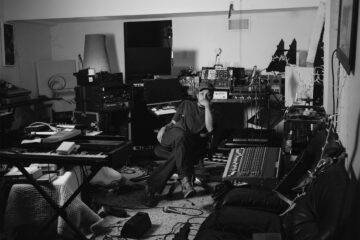Pulling the blanket up to her nose, she is sceptical about the sun that has appeared on the horizon overnight after a long, cold April. But slowly the window pane transforms into a moving car window and the summer begins to pass: »As a songwriter and artist, you are encouraged to romanticise the world around you—you can dream about anything,« says Charlotte Day Wilson. Her recently released album »Cyan Blue« chases away the last of the winter blues and transforms feelings into a cosy melancholy that echoes from the car radio. An aspect that is very much in the artist’s spirit: »I only listen to music in the car, so I wanted my record to be good car music«.
Related reviews
Wilson’s world is literally »cyan blue«: »When I hear two versions of something, I can hear which one is blue and which one is orange. And when I was working on this project, a green-blue world was very present. So I made all my creative decisions through that lens.« The Canadian artist has synaesthesia, »which means I can hear the colour, but I can’t see the music«. While this approach may not be accessible to everyone, you intuitively understand it when you listen to »Cyan Blue«: Charlotte Day Wilson works through her feelings and gives sound to the intangible—the resonance of which becomes colour.
»I hope people who listen to my album don’t think they know everything about me. I would rather they listen to the music and learn something about themselves«.
Charlotte Day Wilson
»I truly believe that music is the most powerful form of art. If you think about it, music is just air! Scientifically, it’s a combination of vibrations working in harmony. But ultimately, it’s a spiritual experience to know how to combine those vibrations in each moment.« One moment Wilson’s music can be the blanket you pull up to your nose, the next the dream of distance: »I hope people who listen to my album don’t think they know everything about me. I would rather they listen to the music and learn something about themselves«.

Other people’s standards
For the R’n’B singer, however, the experience becomes a space that does not disintegrate in the next moment, but bundles time: »I wanted to talk to younger versions of myself and explore how things look and feel at different stages of my life.« This transforms the album into a collage of transience, depicting the different stages of loss and grief. Although Wilson sings through her own anger, Cyan Blue is never cynical: »In the end, anger is usually just pain and sadness.«
»I’m free. I’m not bound by self-doubt and criticism, and this is my portal into a new era of freedom«
Charlotte Day Wilson
Working with Jack Rochon, who took over much of the production, Charlotte Day Wilson was able to enter a state of flow that left a wealth of space for vocals and lyrics: »With this record, I was able to let the music and the feelings come out as they happened.« The Canadian artist knows all too well that letting go often fails, and not just because of the hurdles you place in your own path: »I think a lot about the gender aspect of making music. As women, when we express feelings that are a little ugly—whether it’s fact or fiction—we often want to be liked or to protect others.« Wilson sees rappers as role models: »They don’t give a shit. They say whatever they want to say. You can learn something from that.«
Breaking free from such external standards is at the heart of »Cyan Blue«: »It’s liberating that I’m at a point in my career where I have enough opportunities to show who I am as an artist and the freedom to explore completely different things«. If it comes to it, a dance album or a folk album could also be on the cards in the future—Charlotte Day Wilson is open to the idea and literally lets her hair down: »The hair blowing in the wind on the album cover means: I’m free. I’m not bound by self-doubt and criticism, and this is my portal into a new era of freedom.«










